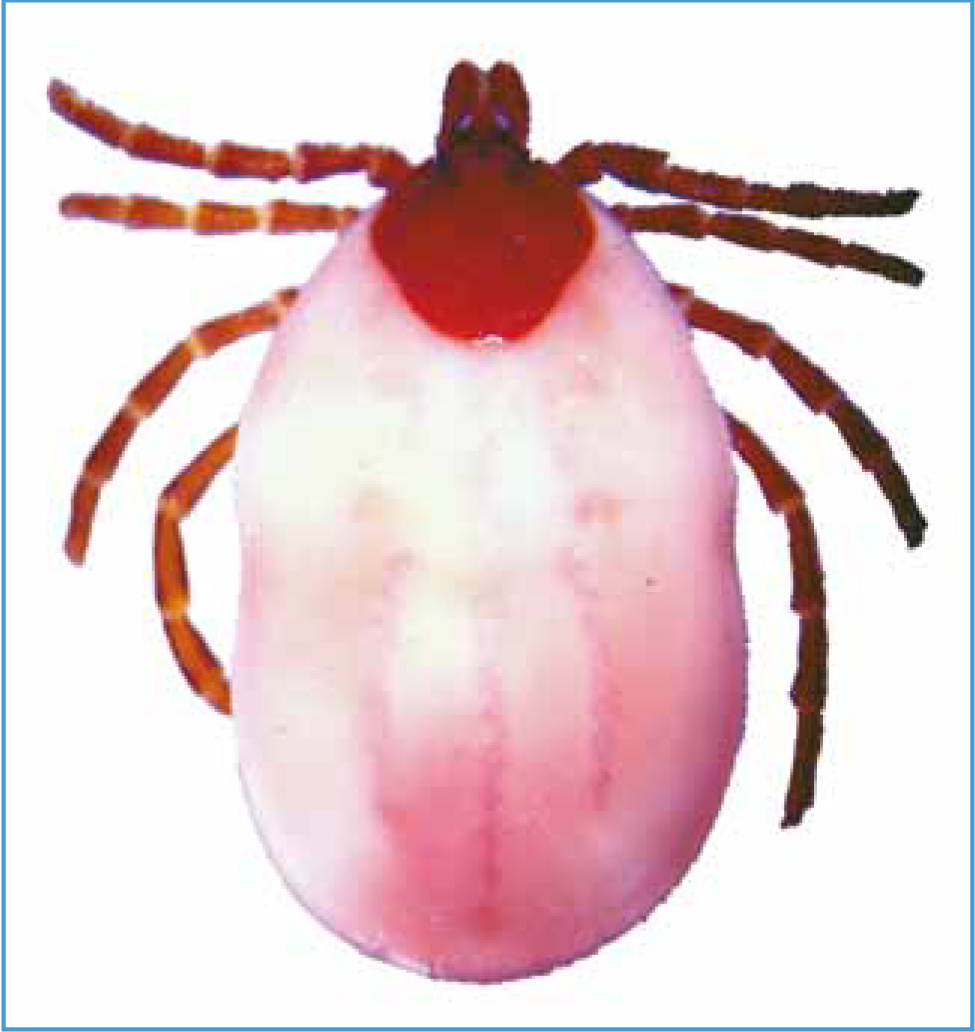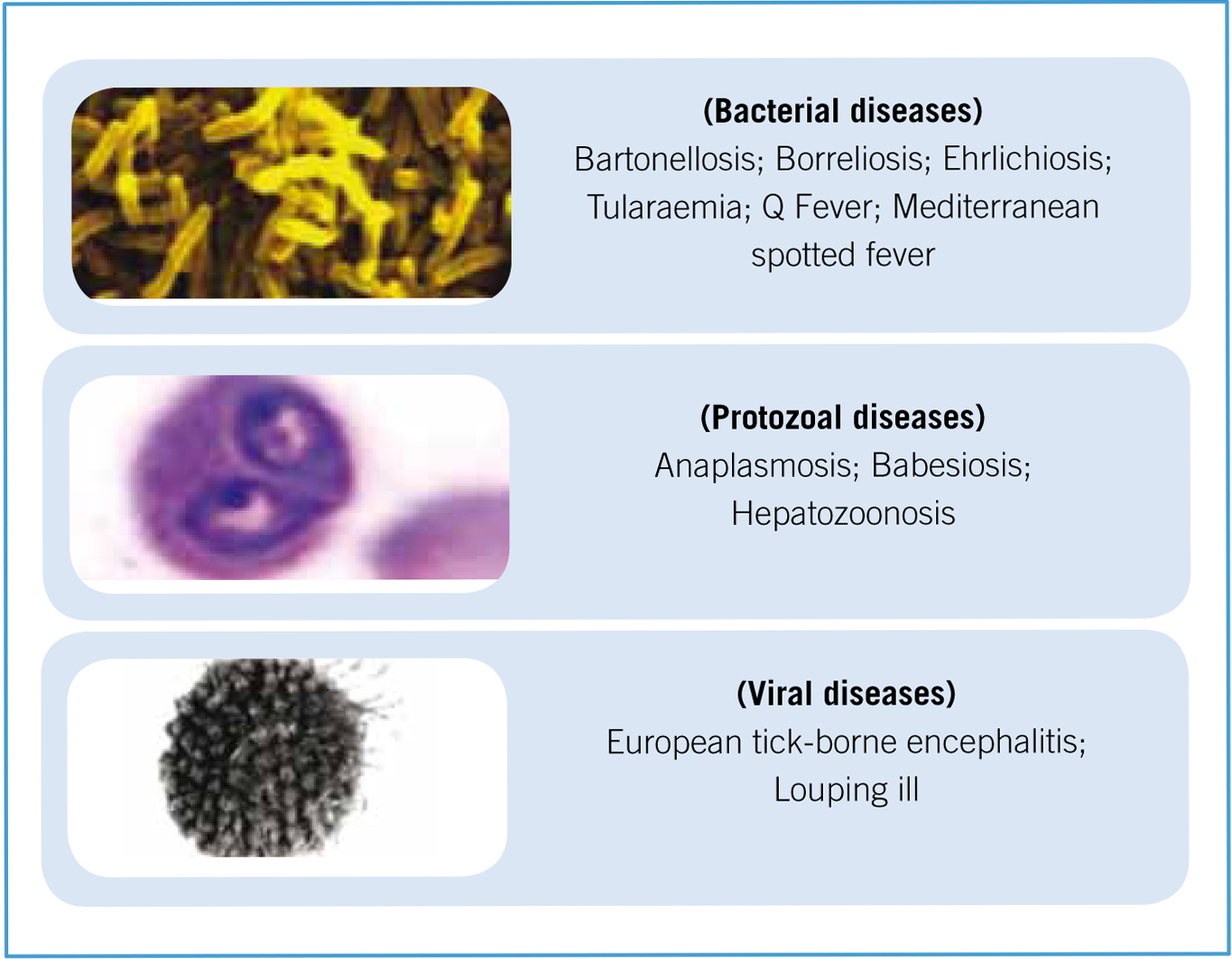Ticks are acarids (phylum Arthropoda), which have a major veterinary and public health impact. Ticks have been known as source of disease for more than a century. Ticks are found in most parts of the world, and more than 900 species have been identified. The geographic distribution of these many tick species varies, with some species more prevalent than others. Since the new Pet Travel Scheme (PETS) rule on tick treatment came into effect on 1st January 2012, there has been increasing focus on ticks and the diseases a tick bite can cause, and there are growing expectations that some exotic tick species may become established in parts of the UK, and affect resident dogs and humans (Abbott et al, 2011; cGarry and Fisher, 2011; Morgan and Smith, 2012).
Ticks in Europe pose an additonal disease threat to animals and humans, besides existing risks caused by the native tick species. The European tick, Dermacentor reticulatus, has been seen in parts of the UK, along with the establishment of an even more important species, which is very common in Europe, the brown dog tick (Rhipicephalus sanguineus). Both species are very efficient vectors of many diseases (Dantes-Torres, 2008). R. sanguineus can infest kennels and human households, as a result, this exotic tick species can survive easily in the UK's climate because they can live, breed and re-infest the same or other pets and people within a household.
It is important for the health and welfare of both animals and people that exotic ticks do not enter and establish in the UK. Risks to travelling pets from exotic diseases spread by ticks should not be ignored (Mc-Garry, 2011), because they could have profound implications for the health of animals and humans. This risk can be considerably minimised by adherence to good advice on preventive measures, especially application of effective acaricides and/or repellents during the period of the visit overseas. Owners travelling abroad with their pets should seek advice from their animal health advisors on the best use of anti-tick treatments as part of good infection management while abroad. In addition, because some tick-borne diseases (TBDs) are already present in the UK, there is a constant need for pet owners to be vigilant about tick control even if their pet never travels abroad.
This article is concerned with the diseases ticks can transmit to pets and humans. Awareness of TBDs and their transmission and zoonotic potentials is a necessary step toward the prevention of these serious diseases. To provide this awareness, two of the most common TBDs (babesiosis and Lyme borreliosis) in animals, their public health implications and ways to prevent these diseases are discussed.
Ticks are efficient vectors of diseases
Ticks are temporary ectoparasites as they attach to a host for a short period of time to take a blood meal. They are haematophagous and have a remarkable ability to transmit a wide variety of pathogens to animals and humans compared with other arthropods. Ticks can transmit infectious pathogens to the host mechanically when they move from one host to another and their mouthparts are soiled with blood-containing agents. They can also transmit pathogens biologically, where the pathogen undertakes some development or maturation within the tick. After this occurs, the pathogen is transferred either transstadially (from one tick stage to the next) or transovarially (from female to offspring via the egg).
The important role of ticks in disease transmission is reinforced by the fact that ticks have a worldwide distribution, can adapt to diverse ecological niches and feed for extended periods of time and on a variety of vertebrate animals as they develop from juveniles to adults. Ticks have salivary glands that play a major role not only in pathogen transmission and establishment, but also in the secretion of bioactive products of various critical functions, such as antihaemostatic, anti-inflammatory and immunosuppressive (Bowman and Nuttall, 2008). Ticks have a long, slow life cycle that takes several years. Because of this longevity, ticks can carry infectious organisms over prolonged periods of time, thus not only acting as vectors, but also serving as reservoir hosts for the pathogens they transmit. Ticks can also benefit from the pathogens they carry. For instance, the presence of the bacteria Anaplasma phagocytophilum in some tick species increases the ability of ticks to survive in the cold temperatures by upregulating an antifreeze glycoprotein (Neelakanta et al. 2010). The increased survival of infected ticks allows the vectored pathogen to carry on in the environment.
Endemic ticks in the UK
The sheep tick Ixodes ricinus and the hedgehog tick I. hexagonus are the most abundant and widespread ticks seen on companion animals, livestock or people. A third species, I. canisuga feeds on dogs and is associated with boarding kennels. Of these, only I. ricinus is an efficient vector of TBDs. Despite the limited knowledge of the full distribution of the I. ricinus in the UK and Europe, this important vector species has been recorded from dogs all over the UK and is extending its range northwards and is increasing in abundance due to the warmer wetter winters. I. hexagonus appears to be a more southerly species (Smith et al. 2011). Interestingly, D. reticulatus, regarded as a continental species, has been reported in the southern parts of England (Smith et al. 2011), representing a newly established population besides foci previously identified on the Welsh coast and on the Welsh border with Shropshire. Tick populations in the UK and northwest Europe are thought to be increasing due to climate change (Gray et al. 2009), changes in land use, companion animal movements and increasing populations of wildlife. These factors also increase the risk of transported exotic ticks, especially the most important ones, D. reticulatus and R. sanguineus, increasing the risk of their spread and establishment.
TBDs
Ticks are obligate blood feeders and are relatively large (2-20 mm long). This wide range in size is because a single hungry female tick swells over 10-fold its unfed size (Figure 1). They have a major veterinary significance due to: economic losses (an estimated $14 billion a year worldwide); direct damage via blood loss, local cutaneous injury and inflammation); and their capacity to transmit a number of infectious diseases (Figure 2), the most important of which are babesiosis and Lyme borreliosis. More details of the important TBDs of pet animals can be found in published literature (Barber et al, 2004; Morgan and Smith, 2012). Further information and advice to pet owners and animal care professionals are provided by ESCCAPUK (www.esccapuk.org.uk).


Babesiosis
Babesiosis is a blood protozoal disease caused by tick-transmitted intraerythrocytic protozoa of the genus Babesia. These protozoan organisms live in the red blood cells of mammals. Babesia species found in companion animals include: Babesia canis and B. gibsoni (in dogs), B. felis and B. cati (in cats). A definitive diagnosis of Babesia infection is usually made by the observation of Babesia parasites in Giemsa-stained thin blood films, where Babesia organisms appear as piroplasm or like a teardrop (Figure 3). Serological techniques (e.g. enzyme-linked immunosorbent assay (ELISA) or immunofluorescence antibody test (IFAT) are also available, and molecular techniques (e.g. polymerase chain reaction (PCR)) are useful when the identification of the causal species is needed. Clinical illness in infected dogs can range from a hyper-acute, shock-associated, haemolytic crisis to a subclinical infection. Clinical signs include lethargy, fever, enlarged spleen, swollen lymph nodes, haemolytic anaemia, haemoglobinuria, pale mucous membrane, jaundice (caused by increased bilirubin in the blood), depression, loss of appetite leading to weight loss, tachycardia, tachypnoea, and in severe cases acute collapse, multiple organ failure, and death (Irwin, 2010). Severely affected animals often require supportive care, so the cost of treating an animal with this disease can be significant.

Human babesiosis is a significant emerging tick-borne zoonotic disease. There are several species of Babesia that can infect humans, but B. microti (a rodent species) and B. divergens (a bovine species) are the most prevalent etiological agents of human babesiosis in the US and Europe, respectively. Transmission via blood transfusion has been reported in the USA (Herwaldt et al, 2011). Babesia causes lysis of erythrocytes resulting in haemolytic anaemia, which in severe cases may lead to organ failure and death, particularly in immunocompromised people.
Borreliosis (Lyme disease)
Lyme borreliosis is the most common TBD in Europe. Corkscrew-shaped Gram-negative spirochete bacterium (Figure 4) known as Borrelia burgdorferi, is the pathogen causing this disease in animals and humans (Greene and Straubinger, 2006). It is estimated that, in Western Europe, up to half of all ticks carry the bacteria (http://www.medfrontiers.com/news203.html). Numerous clinical forms have been associated with Lyme disease in dogs (Littman et al, 2006). This multisystemic disease causes fever, lameness, stiff joints, arthritis, fatigue, renal failure, heart disorders, meningitis, and other neurological signs. Once the host contracts Lyme's disease, urgent treatment with antibiotics is required. Doxycycline or amoxicillin are the drug of choice. However, doxycycline should not be used in very young pups because it can cause teeth staining. Other drugs, such as amoxicillin, ceftriaxone and high-dose penicillin have been found to eradicate the disease and cure Borrelia infection in mice models (Moody et al. 1994). Non-steroidal anti inflammatory drugs may also be used for symptomatic treatment. The current canine vaccine consists of killed B. burgdorferi in adjuvant.

Borrelia burgdorferi sensu lato is the agent of Lyme Borreliosis in humans, a multi-system disorder that is treatable with antibiotics, but may lead to severe complications of the neurological system, the heart, and the joints. The early symptoms of the illness are mild. However, if left untreated, it can cause severe damage to the skin, the joints, the heart and the nervous system, and then, effective therapy becomes very difficult. Treatment requires a course of antibiotics lasting several weeks. The application of a transparent, self-adhesive plaster containing the antibiotic azithromycin to the site of the tick bite has been shown to rapidly cure the infection with minimal side-effects in animal models (Knauer et al. 2011). Although, patients still undergo antibiotic treatment for several weeks.
Differential diagnosis can be difficult, and co-infection, particularly with Babesia spp or Ehrlichia spp can occur. Diagnosis of Lyme disease in humans are with enzyme-linked immunosorbent assay (ELISA) and immunofluorescence assay. Newer serologic tests used in humans and dogs directed against a synthetic C6 peptide derived from the VlsE antigen have a high correlation with natural infection and higher sensitivity (Ague-ro-Rosenfeld, 2008).
Control and management of ticks and TBDs
Tick control measures, such as acaricides applied to tick habitats and/or hosts are available. There are a number of products that can help reduce the risk of pet exposure to ticks (Lloyd and Blunt, 2011). However, there is no single treatment that covers all the parasites. Check the most up-to-date product information provided by the manufacturer of each drug for relevant species of tick, required duration of action, adverse effects, potential for drug interactions, accidental contact etc. Some of the disease prevention products need to be administered well before potential exposure to the disease causing agents. An assessment of the risks facing each pet is required, which will depend on which countries the pet will be visiting and the season of year the travel will be scheduled. Further information on tick control including different acaricides available can be found at the ESCCAPUK website (www.esccapuk.org.uk).
The majority of tick prevention programmes stress habitat modification (e.g. burning tick habitat, leaf litter etc) and personal protection measures. Personal protection measures include:
Although these efforts are useful, the research evidence for the efficacy of these measures is lacking and they are often impractical to achieve. The increasing occurrence of TBD (Jaenson et al. 2012) despite multiple prevention measures indicates that more effective measures are needed in order to control and manage these diseases. Veterinary staff need to be aware of which factors increase risk of diseases transmitted by ticks, and utilise and promote effective means for their prevention in order to reduce the incidence and spread of these diseases in the future.
Conclusion
Prevention of TBDs should be based primarily on increasing the awareness of veterinarians, physicians and the public to the risks imposed by these diseases. It is important to treat the pets for ticks while abroad, and to continue treatment on return because some TBDs are already endemic in the UK. Treatment of TBDs should be initiated on suspicion, because these diseases are not detectable in the blood soon after the animal or human has been bitten by an infected tick (it can take days to months for them to become detectable). Besides TBDs, there are many other diseases transmitted by other vectors (e.g. leishmaniosis by sandflies and dirofilariosis by mosquitoes) that Britain is free of, and that are endemic in many countries, from which companion animals can travel. Those should be also taken into account when devising control strategy for pets travelling to/from endemic countries.
